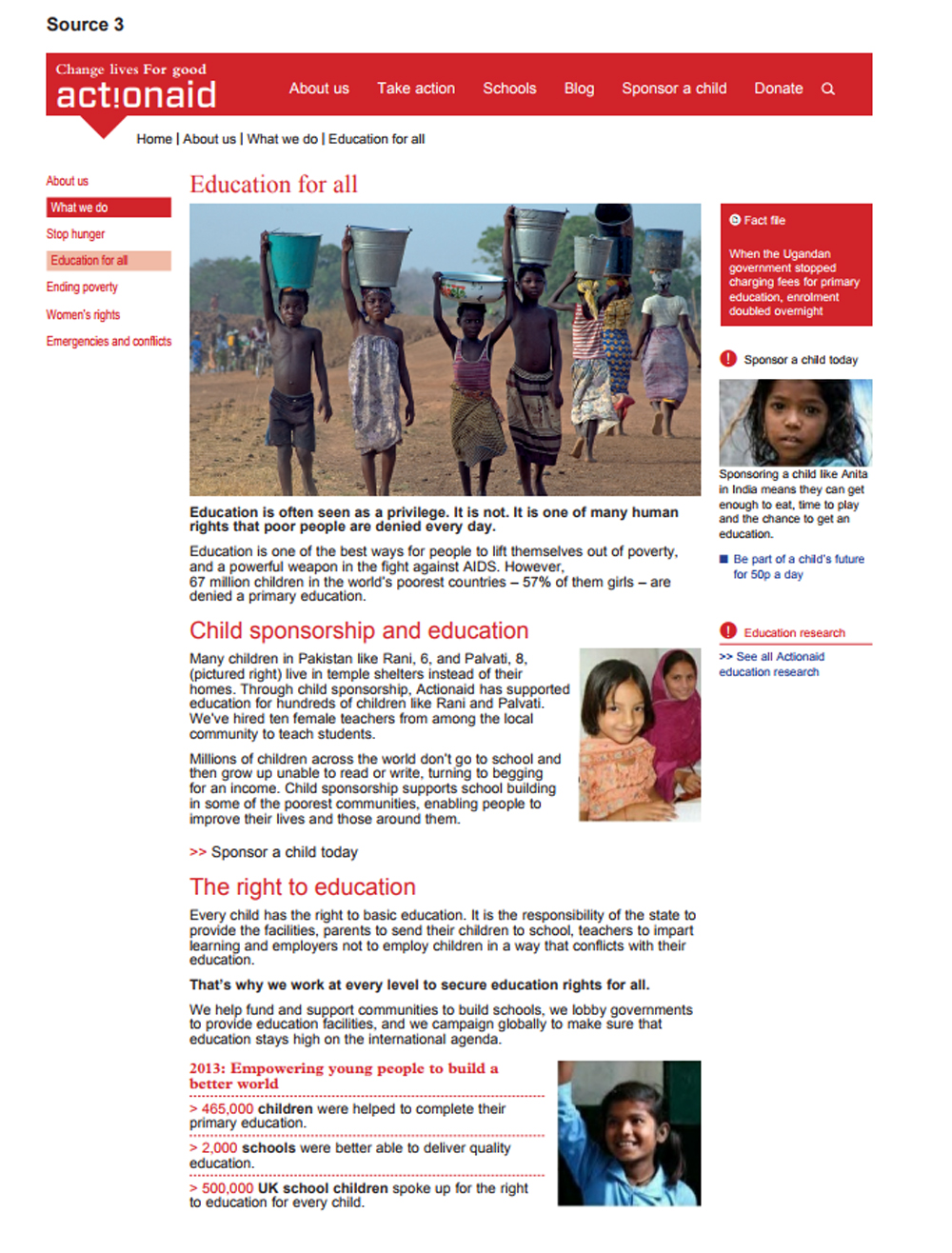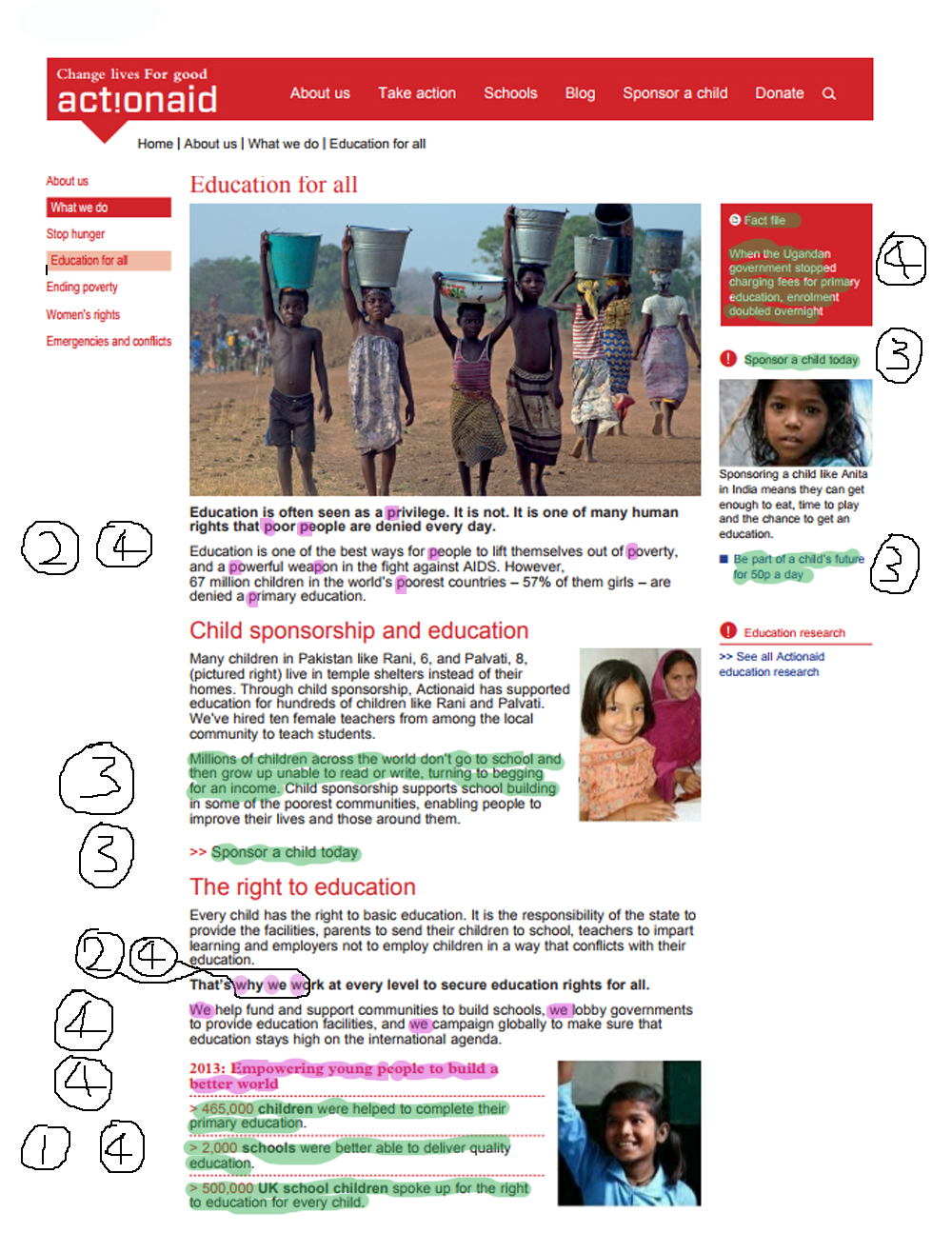More examples – 1
We have not finished with the examples yet! The following THREE examples (on this and the following two pages) are from actual exam papers that GCSE students had to answer in recent years (unlike the examples above, which were written by us).
Why three more examples? Because we believe that practise really does make perfect (or as near-perfect as possible). Once you have completed all four of these, you should be very well prepared for this particular part of your exam.

The question:
"Read the webpage for the charity, ‘Actionaid’.
How does the writer use language features for effect on the webpage?
Remember to:
- give some examples of language features
- explain the effects"
This is how we suggest you tackle this question:
1. Write down the four language feature (PSPS) headings:
- Pretending
- Sound
- Persuasion
- Speech
2. Highlight each of the headings in a different colour, e.g.:

3. Write down the four effects headings, numbering them 1 to 4:
- Understand
- Sense
- Respond
- Remember
4. Now read through the source text and highlight every language feature heading you encounter in the highlight colour you’ve given it.
5. Consider the effect that each highlighted language feature has on you and write down the number of the effect heading (from step 3 above) next to the appropriate highlighted text.
The source text should now look something like this:

In this example, the pink highlighting represents “Sound” and the green highlighting is for “Persuasion”. As you can see, there are lots of “Sound” and “Persuasion” language features in this source, a website designed to get readers to take action by sponsoring a child in need of help. However, there is no “Pretending” and no “Speech” – the language is clear and direct, rather than dreamy and atmospheric. However, we have found ALL FOUR of the effect headings in this webpage – 1. Understand, 2. Sense, 3. Respond and 4. Remember, although Respond and Remember proved to be the most common, which you would expect for a webpage designed to inform and get people to play a part.
So now, having read and understood the source and marked up the features and responses we’ve found, it’s time to answer the question.
(As before, text in red is for your guidance only and would not be included in your answer.)
Brief introduction
The Actionaid website page is designed to persuade site visitors to respond by signing up to sponsor the education of children in the world’s poorest countries. It contains many language features designed to persuade, from pathos to imperatives, and empathy to a list of statistics confirming some of the charity’s successes.
Language feature: sound – alliteration
They may not all be deliberate, but there are lots of “p” sounds in the first two paragraphs of the main text. It is perhaps more noticeable in the second paragraph: “Education is one of the best ways for people to lift themselves out of poverty, and a powerful weapon in the fight against AIDS. However, 67 million children in the world’s poorest countries – 57% of them girls – are denied a primary education.”
Effect – sense and remember
Alliteration is pleasing to the ear (or the “mind’s ear” when reading silently), and also aids memory of the words. The reader is more likely read on.
Language feature: persuasion – pathos
The statement: “Millions of children across the world don’t go to school and then grow up unable to read and write, turning to begging for an income” is clearly intended to make the reader feel pity and sadness for people who, through no fault of their own, lose out on education and so have an extremely difficult, if not perilous future.
Effect – respond
Pathos like this, pitched at the right level (i.e., not excessive or verging on rhetoric) can push the reader beyond the tipping point between inaction and actually doing something – a positive response.
Language feature: persuasion – imperative
The link (at least I guess it’s a link – can’t be tested as this is just an image of the webpage) that reads “Sponsor a child today” is an imperative that may persuade many visitors to click for more information. “Sponsor a child” (without “today”) might have been considered, but “Sponsor a child today” indicates that you, the reader could actually do this now.
Effect – respond
It is rather like retailers’ signs that proclaim: “Take it home today!” (though for a much more laudable cause). People usually don’t like waiting for things to happen – if they’ve made up their minds, they want to do it now! Instant response is the name of the game.
Language feature: sound – alliteration
There is further alliteration in “That’s why we work at every level . . .”
Effect: sense; respond; remember
Again, this is pleasing to the ear, appealing to the senses, and makes the words more memorable.
Language feature: sound – repetition (triplet)
The word “we” is repeated three times in: “We help fund and support communities to build schools, we lobby governments to provide education facilities, and we campaign globally to make sure that education stays high on the international agenda”. Repetition is a very effective device, and using a word three times to start adjacent sentences or clauses is a recognised rhetorical technique.
Effect: remember
The repetition gives emphasis and aids memory.
Language feature: sound – consonance, assonance and alliteration
The consonance, assonance and alliteration in: “2013: Empowering young people to build a better world” makes this heading very readable and memorable, and pleasing to the ear.
Effect: response, remember
It makes the words more memorable and the reader is more likely to respond by reading the information underneath.
Language feature: persuasion – listing positive facts
Under the heading mentioned above, there are three statistics that show what a brilliant job Actionaid apparently did in 2013: 465,000 children were helped to complete their primary education; 2,000 schools were better able to deliver quality education; 500,000 UK school children spoke up for the right to education for every child.
Effect – understand, remember
Although detailed analysis might render some of these claims a little spurious (for instance, in what way did 500,000 UK school children “speak up” for the right to education for every child; to whom did they speak up; and what difference did that make?) they are presented as evidence of what the charity did in a particular year and the figures are impressive to say the least. It is fairly certain that these facts will influence many readers. As a result, they will understand more about Actionaid’s achievements, be more likely to sponsor a child or help in some other way, and probably remember at least some of the great work Actionaid is doing.
Language feature: persuasion – another fact
The fact that when the Ugandan government stopped charging primary school fees “enrolment doubled overnight” looks like another great achievement for Actionaid (presumably they campaigned/lobbied for this).
Effect: understanding and remember
Such a fact, highlighted in a coloured text box at the top right of the page, informs (aids understanding) and influences would-be sponsors and is quite memorable.
Language feature: persuasion – imperative
The two imperatives, “Sponsor a child today (repetition of the link half-way down the main text) and “Be part of a child’s future for 50p a day), are designed to get people to make an immediate response. By clicking either of these links, the reader will be presented with the means of becoming a sponsor.
Effect: respond
The effect is to get people to respond. The suggestion that this costs 50p per day will be attractive to many – but perhaps not so attractive if they stop to consider that this is £15.50 a month (for most months). It’s a bit like: “Drive this car away today for just £30 a week” – sounds cheap, but it’s more than £120 a month.
At least, in Actionaid’s case, this is for what appears to be an excellent cause.




